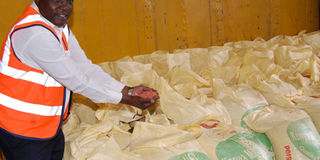Improved seeds to improve Kenya’s maize yields

Sylvester Opil Ndeda, a plant breeder and liaison manager at the East African Maltings Limited in Molo, Nakuru County, shows sorghum seeds at the plant on July 23, 2019. PHOTO | FRANCIS MUREITHI | NATION MEDIA GROUP
What you need to know:
- Uganda produces an average of 2.5 tonnes per hectare, while Malawi produces 2.0 tonnes per hectare.
Some of the African countries with poor yields include Mozambique with 0.9 tonnes per hectare, Rwanda (1.2) and Tanzania (1.5).
Records show that by 2017, Kenya had released about 98 varieties of maize seeds in a bid to respond to climate change.
Kenya’s average maize yield of 1.5 tonnes per hectare could match those of African leading producers of the crop if farmers use improved seeds.
The latest report by The African Seed Access Index (TASAI) indicates that Egypt, with a yield of 7.7 tonnes per hectare, leads the continent in maize production.
South Africa, with a yield of 6.4 tonnes per hectare, is the second largest producer of maize followed by Ethiopia with 3.7 tonnes per hectare.
Uganda, which has been exporting maize to Kenya, produces an average of 2.5 tonnes per hectare, while Malawi produces 2.0 tonnes per hectare.
Some of the African countries with poor yields include Mozambique with 0.9 tonnes per hectare, Rwanda (1.2) and Tanzania (1.5).
NEW TECHNOLOGY
According to Mr Mainza Mugoya, Programme Coordinator, The African Seed Access Index (TASAI), Kenya and other African countries stand a chance to boost their yield if they adopt new technology.
“Improved seeds are resistant to pests and diseases. They adapt well to climate change and have improved nutritional value besides longer shelf life,” said Mr Mugoya.
Records show that by 2017, Kenya had released about 98 varieties of maize seeds in a bid to respond to climate change.
The deadly fall armyworm is still ravaging maize crops in Kenya’s food basket of South Rift Valley.
The official, however, said that even with improved seeds in the market, smallholder farmers were slow in adopting the seeds.
He said this is attributed to quality, affordability, accessibility and competitive seed systems serving smallholder farmers.
He said the low number of breeders in most African countries was also to blame.
SEED COMPANIES
For instance, the number of breeders in Kenya for priority food crops is 34 in comparison to Egypt which has 74 and South Africa 54 and Tanzania 46.
Most breeders in Kenya are employed in public research institution such as Kenya Agricultural Livestock and Research Organization (Kalro).
However, some seed companies supplement the government efforts and have employed their own breeders.
Kenya has a vibrant seed companies with about 20 of them operating in the country.
Mr Mugoya was presenting a paper titled African Seed Access Index during the recent Kenya Science Journalists Congress in Mombasa which was attended by science journalists and experts from Kenya, Uganda, Tanzania, Rwanda and Malawi.
The congress held between November 18-20 was organised by the Media for Environment, Science, Health and Agriculture (Mesha).
“Breeding is critical as it responds to farming challenges, climate change, low yields and diseases among other challenges,” said Mr Mugoya.
STAPLE FOOD
Kenya was still recording a low maize production despite heavy focus on the staple food crop.
Other key food crops such as cow pea, sorghum, beans, soya beans and pigeon peas and rice have recoded under investment from the national government. By the end of 2017, a total of 314 maize varieties were released in Kenya with 43,954 tonnes sold to farmers.
In comparison, sorghum had 30 varieties, beans 31 and cowpeas 10 varieties released. To stamp out fake seeds which affects farmers’ confidence and productivity in formal seed system, local companies introduced security labels in the packaging materials.
“Formal seed sector is moving towards liberalisation and we need to adopt a seed systems approach to address challenges in the African seed sector,” concluded Mr Mugoya.




